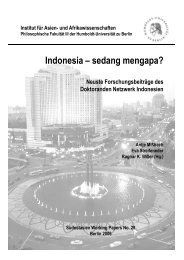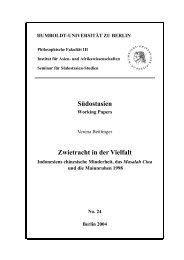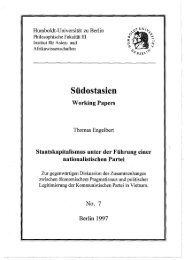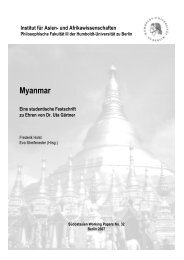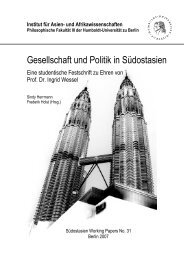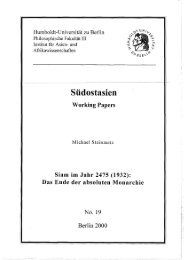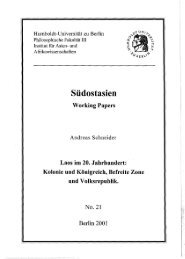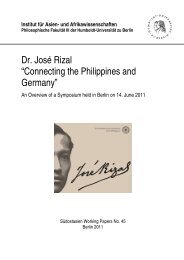On Centrism and Dualism - Humboldt-Universität zu Berlin
On Centrism and Dualism - Humboldt-Universität zu Berlin
On Centrism and Dualism - Humboldt-Universität zu Berlin
You also want an ePaper? Increase the reach of your titles
YUMPU automatically turns print PDFs into web optimized ePapers that Google loves.
INTRODUCTION<br />
historically with images that stress oneness: as mountains, stable <strong>and</strong> round; as umbrellas,<br />
round <strong>and</strong> shading; or as banyan trees, 14 rooted, protecting <strong>and</strong> overarching. ‘Centrist’<br />
societies are said to regard men <strong>and</strong> women qualitatively as very much the same sort of<br />
creature: as descendants from a common ancestral source. ‘Centrist’ societies are said to<br />
stress the unity of the sexes as brothers <strong>and</strong> sisters <strong>and</strong> not their difference as man/woman or<br />
husb<strong>and</strong>/wife.<br />
ERRINGTON argues that the multiple permutations that express these basic ideas of social<br />
organization in a variety of contexts may give the impression of noncomparability. Yet, she<br />
claims that a House-centric perspective will reveal that most isl<strong>and</strong> Southeast Asian societies<br />
can be viewed as transformations of each other <strong>and</strong> that they are, thus, compareable.<br />
In my discussion of ERRINGTON’S comparative model I will concentrate on those aspects of<br />
her model that are said to constitute its characteristic features: houses, siblingship, <strong>and</strong><br />
marriage (cf. CARSTEN 1995a: 122). While exploring these contexts it became evident that the<br />
relationships hierarchy/seniority <strong>and</strong> complementarity/siblingship are crucial elements for a<br />
proper underst<strong>and</strong>ing of her model. Therefore these central relations will be introduced in<br />
some detail.<br />
My exploration of ERRINGTON’S comparative approach aims at identifying <strong>and</strong> summarizing<br />
her model’s theoretical premises. At the same time I am intending to highlight the symbolic<br />
significance of cross-sex siblingship for isl<strong>and</strong> Southeast Asian societies. My in-depth<br />
discussion of cross-sex siblingship aims at underst<strong>and</strong>ing how the House’s unity is imagined<br />
<strong>and</strong> expressed in ERRINGTON’S model. Furthermore I want to stress that ERRINGTON’S major<br />
contribution to the anthropology of Southeast Asia lies in her attempt to highlight the<br />
relevance of these cognatic cross-sex relations. Concluding I will argue that the idea of unity,<br />
imagined via cross-sex siblingship, represents common theme in ERRINGTON’S model, that<br />
unites ‘Centrist’ <strong>and</strong> ‘Eastern Indonesian’ societies structurally <strong>and</strong> identifies them as<br />
transformations of each other.<br />
In the concluding chapter I will discuss some other theoretical concepts that also seem to be<br />
of relevance for ERRINGTON’S characterization of isl<strong>and</strong> Southeast Asian societies, without<br />
being explained by her explicitly. Furthermore, I will affirm some already stated criticism<br />
made by various scholars pertaining to ERRINGTON’S heuristic perspective. My final<br />
discussion will add some further points to this already existing corpus of criticism. Thereby, I<br />
will concentrate on her comparative approach <strong>and</strong> her conception of ‘Centrist’ societies, an<br />
14 Ficus benghalensis<br />
10



